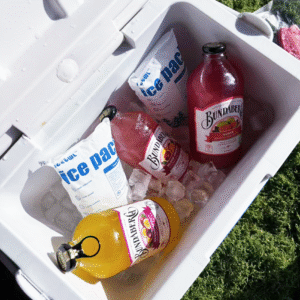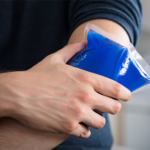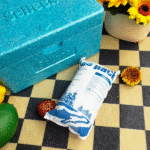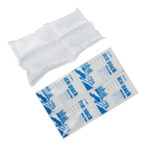Se você precisar de um preciso, resposta segura rápida: a melhor escolha geral para um 10 saco de gelo seco lb é um desabafou 12″ × 16″ LDPE plano (2–3 milhões); para uma embalagem vertical, use a ventilado reforçado 10,5″ × 10,5″ × 21″ (2–3 milhões). Ambos cabem em um típico 10″ × 10″ × 2–2⅜” bloquear, deixe espaço dobrável, e conhecer 2025 lidar com as melhores práticas. Você fará as malas mais rápido, fique em conformidade, e cortar quebra.
-
Qual 10 O tamanho do saco de gelo seco em lb se ajusta melhor?—com orientação de cauda longa como 10 Dimensões do saco de gelo seco em lb.
-
Qual deve ser a espessura do filme?-espessura do saco de gelo seco ventilado para manuseio brusco.
-
Como você calcula o tamanho da sacola a partir do volume?—um método simples que você pode reutilizar.
-
Como você embala para conformidade?—rótulos, ventilação, e Gelo seco UN1845 pontas.
-
O que há de novo 2025?—materiais, sensores, e sustentabilidade que afetam sua escolha.
Qual 10 O tamanho do saco de gelo seco em lb funciona melhor em 2025?
Resposta curta: Use um ventilado 12″ × 16″ 10 saco de gelo seco lb (2–3 milhões) para blocos planos “fatiados”, ou um ventilado 10,5″ × 10,5″ × 21″ 10 saco de gelo seco lb para carregamento vertical. Ambos fornecem folga segura, fácil de dobrar, e rotulagem limpa. Evite fechamentos herméticos.
Por que isso se encaixa? UM 10 bloco lb é normalmente ~10″ × 10″ × 2–2⅜”. Um 12″ largura plana limpa os 10″ rosto com folga de inserção; 16″ altura deixa espaço para dobrar sem vedar. A pegada reforçada reflete os 10″ × 10″ face para empilhamento limpo em caixas. A ventilação evita o acúmulo de pressão e atende às normas de manuseio estilo IATA/OSHA.
Plano vs.. reforçado 10 saco de gelo seco lb - como escolher
Plano (12″ × 16″, 2–3 milhões, ventilado): Mais fácil de obter, rápido para carregar, dobramento generoso.
Reforçado (10.5″ × 10,5″ × 21″, 2–3 milhões, ventilado): Autônomo, pegada arrumada, melhor para caixas estreitas.
Ajuste apertado do forro (≈10″ × 10″ × 3″ reforçado): Use apenas dentro de revestimentos rígidos quando desejar espaços de ar mínimos e espaço livre controlado.
| Cenário | Recomendado 10 saco de gelo seco lb | Espessura do filme | O que isso significa para você |
|---|---|---|---|
| Bloco plano de “fatia” (10″ × 10″ × 2–2⅜”) | 12″ × 16″ deitado, ventilado | 2–3 milhões | Carregamento rápido, dobrável confiável, ampla disponibilidade |
| Vertical em caixa/forro | 10.5″ × 10,5″ × 21″ reforçado, ventilado | 2–3 milhões | Pegada limpa, melhor empilhamento, limpador desembalar |
| Manuseio grosseiro / fragmentos | 13″ × 20″ deitado, ventilado | 3–4 milhões | Circunferência extra para fragmentos; menos lágrimas |
| Apertado dentro do forro rígido VIP/EPS | ~10″ × 10″ × 3″ reforçado, ventilado | 3 mil | Espaço livre mínimo, sublimação mais lenta (nunca hermeticamente) |
Dicas práticas que economizam tempo e produto
-
Deixe um caminho de ventilação. Dobre – não sele a quente – o 10 lb boca de saco de gelo seco.
-
Pré-resfrie o remetente. O pré-resfriamento reduz os picos iniciais de sublimação.
-
Carga separada. Adicione uma divisória rígida para manter o produto fora do bloco.
Caso real: Um remetente de sobremesas mudou de 10″ × 12″ para 12″ × 16″ 10 sacos de gelo seco lb (3 mil, ventilado). Os rasgos durante o carregamento caíram drasticamente e o tempo de espera melhorou, graças às dobras mais limpas e à melhor colocação da espuma. Os erros de reembalagem foram eliminados e o controle de qualidade liberou mais caixas de saída por hora.
Como você calcula um 10 saco de gelo seco lb do volume?
Ideia central: Calcular bloco volume, adicionar folga de carregamento, Em seguida, adicione dobrar para ventilação segura.
Passo a passo (Copie isso):
-
Massa → volume: Densidade do gelo seco ≈ 1.56 g/cm³. UM 10 bloco de libras = 4,536 g → ~2.910 cm³.
-
Fatia típica: 10″ × 10″ × 2–2⅜” (≈200–238 pol³).
-
Largura plana: Usar largura ≥ face + 1–2″ folga → 12″ por um 10″ face.
-
Altura da bolsa: altura ≥ espessura × 5–8 para permitir dobras e etiquetas → 16–21″.
-
Headspace: Alvo ~1″ cada lado ou seção transversal reforçada que é igual à face.
Headspace, ventilação, e comprimento de dobra
UM 10 necessidades de saco de gelo seco de lb altura livre dobrável (2–5″) e a boca não hermética. Microperfs, laços de torção soltos, ou uma dobra simples funciona bem. Manter headspace vazio modesto para retardar a entrada de calor, mas nunca retém CO₂.
| Espessura do bloco | Boa altura da bolsa | Boa largura do saco | Significado prático |
|---|---|---|---|
| 2.0″ | 16″ | 12″ | Dobragem fácil; volume mínimo de ar |
| 2.25″ | 16–18″ | 12″ | Espaço extra para dobrar etiquetas |
| 2.375″ | 18–21″ | 12″ | Tolera ligeira variação de bloco |
Quais materiais e espessuras são melhores para um 10 saco de gelo seco lb?
Melhor versátil: LDPE/HDPE com metaloceno (para flexibilidade em baixas temperaturas). Para a maioria das rotas, um 2–3 mil filme ventilado é ideal. Aproxime-se 3–4 milhões para manuseio brusco, fragmentos, ou rotas longas.
-
Por que se misturam LDPE/HDPE? Resistente a -78,5°C, resistir à neblina/fragilidade, e imprimir etiquetas de forma limpa.
-
Quando adicionar um envoltório? Um solto envoltório interno de papel kraft reduz o gelo no filme e amortece as bordas.
-
O que evitar? Sacolas de supermercado finas ou sacolas de “água gelada” sem ventilação – risco de rachaduras e acúmulo de pressão.
Quando aumentar para 3–4 mil em um 10 saco de gelo seco lb
-
Esperam-se fragmentos afiados: Blocos quebrados, reembalagens frequentes.
-
Manuseio de transportadores pesados: Classificação automatizada, Hubs longos.
-
Revestimentos VIP/EPS com tolerâncias restritas: Filme vê mais abrasão.
Como você deve embalar um 10 saco de gelo seco lb para conformidade?
Siga esta sequência para uma operação mais segura, embalagem mais rápida:
-
EPI primeiro. Use luvas isoladas e proteção para os olhos.
-
Enrolar, então saco. Envoltório kraft leve → 10 saco de gelo seco lb (12″ × 16″ deitado ou 10,5″ × 10,5″ × 21″ reforçado), ventilado.
-
Separador rígido. Coloque uma placa/folha de espuma acima do bloco; mantenha o produto fora do contato direto.
-
Externo isolado. Use um refrigerador/transportador ventilado; quebre o dreno/ventilação ou use aberturas projetadas.
-
Etiquetar o remetente externo. ““Gelo Seco / Dióxido de carbono, sólido, UN1845" e Peso líquido (kg).
-
Não sele hermeticamente. Nem o 10 lb saco de gelo seco nem a parte externa pode ser hermética.
-
Pesar e registrar. Registre gelo seco líquido para auditorias e notificações de clientes.
Lista de verificação rápida de conformidade (imprima para sua bancada)
-
10 saco de gelo seco de lb ventilado e dobrado (não selado)
-
Divisória no lugar; nenhum produto tocando gelo seco
-
Exterior tem caminho de ventilação; UN1845 marca + kg líquido no rótulo
-
Folha de embalagem atualizada com peso inicial e tempo de espera alvo
Tendências da cadeia de frio em 2025 que afetam o seu 10 saco de gelo seco lb
O que há de novo: Membranas ventiladas, filmes mais resistentes de baixa temperatura, e revestimentos mais inteligentes estão tornando cada 10 saco de gelo seco lb mais seguro e limpo de usar. As misturas recicladas e de conteúdo biológico estão avançando sem sacrificar a resistência ao impacto. Os transatlânticos VIP e os registradores de dados estendem o tempo de espera e reduzem os eventos de re-gelo.
Resumo dos últimos avanços
-
Filmes de microventilação: Liberação controlada de CO₂ sem perfuração manual.
-
Misturas ricas em metaloceno: Melhor resistência ao rasgo com medidores finos.
-
Forros retornáveis: Reutilize programas que se encaixem nos 10″ × 10″ pegada.
Insight de mercado: Demanda por 10 Os formatos lb permanecem altos em alimentos congelados e produtos biológicos de última milha, favorecendo 12″ × 16″ 10 sacos de gelo seco lb com etiqueta transparente e dobragem rápida.
Perguntas frequentes
Q1: Qual é a escolha mais segura para a maioria das equipes?
Escolha um desabafou 12″ × 16″ 10 saco de gelo seco lb em 2–3 milhões. Ele carrega rapidamente, dobra de forma limpa, e se encaixa no padrão 10″ × 10″ fatias.
Q2: Quando devo usar um reforço 10 saco de gelo seco lb?
Usar 10.5″ × 10,5″ × 21″ quando você quer uma posição vertical, pegada autônoma dentro de uma caixa ou forro.
Q3: Posso selar a quente um 10 saco de gelo seco lb?
Não. Nunca Seal hermético. Dobre ou amarre frouxamente para manter um caminho de ventilação para CO₂.
Q4: Quanto tempo dura um 10 bloco lb por último na prática?
Esperar ~18–36 horas em um refrigerador típico. Os sistemas VIP/EPS podem estender este, assumindo aberturas mínimas.
Q5: E se meus blocos variarem em espessura?
Projeto para 2–2⅜” grossura. Escolha 16–21″ altura para preservar a altura livre dobrável e a ventilação.
Q6: Preciso registrar o peso do gelo seco?
Sim - registro kg líquido inicial para rótulos e auditorias. Simplifica o planejamento da produção de gelo e as verificações regulatórias.
Resumo & Recomendações
Três conclusões:
-
UM 12″ × 16″ ventilado 10 saco de gelo seco lb (2–3 milhões) cabe na maioria 10″ × 10″ fatias.
-
Para pacotes verticais, escolha um 10.5″ × 10,5″ × 21″ ventilado 10 saco de gelo seco lb.
-
Deixe sempre um Caminho de ventilação, Adicione a divisor, e etiqueta UN1845 + NET KG.
PRÓXIMOS PASSOS (faça isso hoje):
-
Padronize em um SKU plano e um SKU reforçado.
-
Imprima a lista de verificação de conformidade para sua bancada.
-
Adicione uma divisória a cada pacote.
-
Execute um teste de tempo de espera de 24 horas e registre a perda de peso.
CTA: Quer uma especificação de uma página para sua linha? Fale com a equipe da cadeia de frio da Tempk para uma revisão rápida da embalagem.
Um pequeno ajudante de decisão (cole no seu SOP)
Links internos sugeridos (no seu site)
-
Gelo seco vs.. PCM: escolhendo a fonte de frio certa → /conhecimento/gelo seco-vs-pcm
-
Lista de verificação de rotulagem UN1845 para embalagens de gelo seco → /conhecimento/lista de verificação de etiqueta de gelo seco-un1845
-
Quanto gelo seco eu preciso por 24 a 72 horas? → /conhecimento/quanto-gelo seco
-
Ventilação do saco de gelo seco: melhores práticas em 2025 → /conhecimento/ventilação do saco de gelo seco
-
Escolhendo o transportador isolado certo → /conhecimento/guia-remetente isolado
Sobre Tempk
Nós projetamos embalagem de cadeia de frio de alto desempenho que equilibra a confiabilidade, conformidade, e custo. Nosso 10 saco de gelo seco lb as opções são projetadas para resistência a baixas temperaturas, limpar dobras, e rotulagem fácil. Com pacotes validados e SOPs de início rápido, nós ajudamos sua equipe a enviar na hora e na temperatura-diariamente.
Pronto para otimizar seu 10 especificação de saco de gelo seco lb? Entre em contato com nossos especialistas para obter uma embalagem personalizada e um guia de linhas de uma página.























